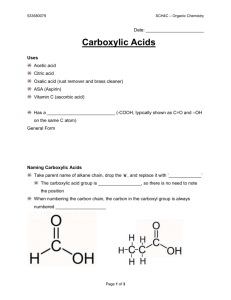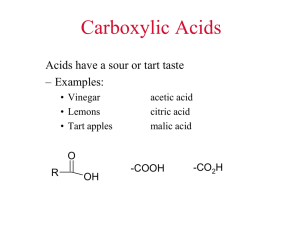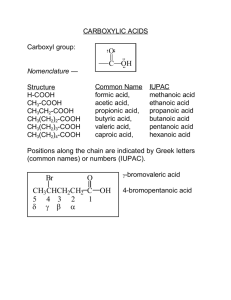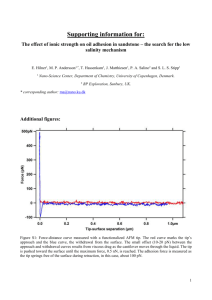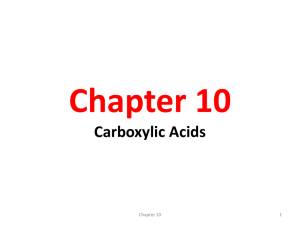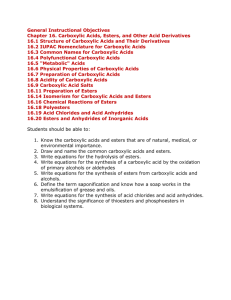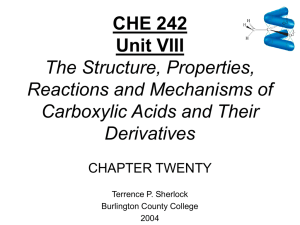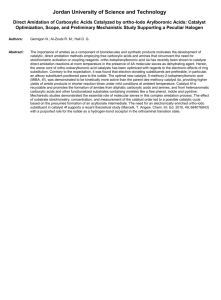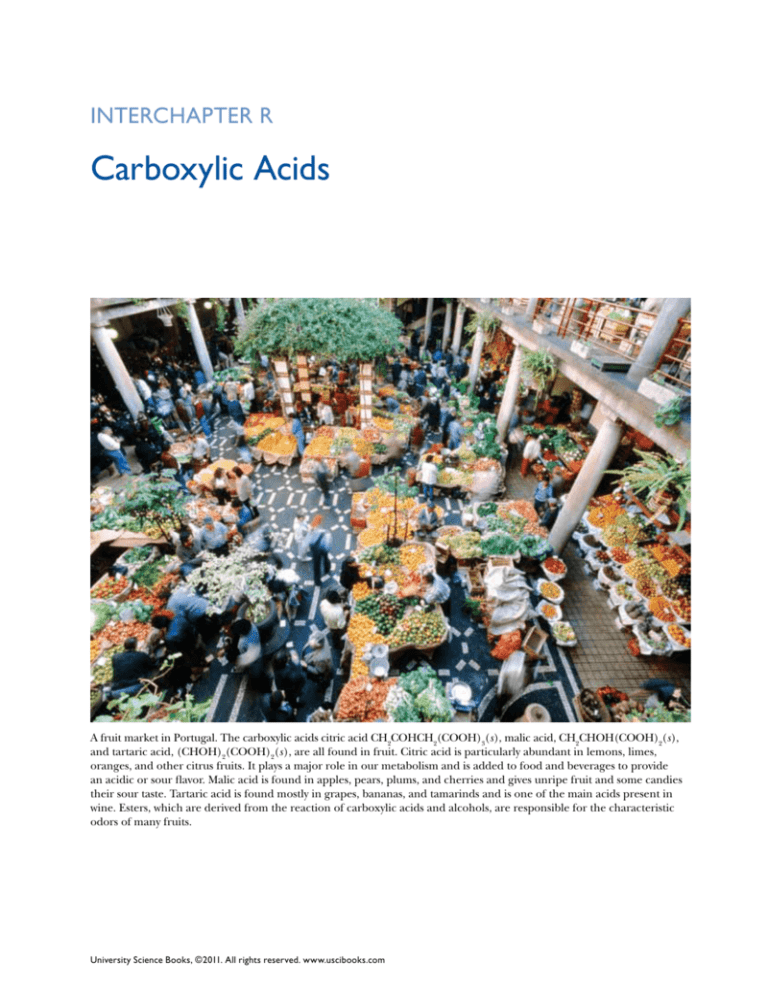
INTERCHAPTER R
Carboxylic Acids
A fruit market in Portugal. The carboxylic acids citric acid CH2COHCH2(COOH)3(s), malic acid, CH2CHOH(COOH)2(s),
and tartaric acid, (CHOH)2(COOH)2(s), are all found in fruit. Citric acid is particularly abundant in lemons, limes,
oranges, and other citrus fruits. It plays a major role in our metabolism and is added to food and beverages to provide
an acidic or sour flavor. Malic acid is found in apples, pears, plums, and cherries and gives unripe fruit and some candies
their sour taste. Tartaric acid is found mostly in grapes, bananas, and tamarinds and is one of the main acids present in
wine. Esters, which are derived from the reaction of carboxylic acids and alcohols, are responsible for the characteristic
odors of many fruits.
University Science Books, ©2011. All rights reserved. www.uscibooks.com
R1
R. Carboxylic Acids
Organic molecules that have the functional group
O
R-1. Carboxylic Acids Can Be Produced by
the Oxidation of Aldehydes
OH
One important use of aldehydes is in the production
of carboxylic acids:
C
(abbreviated –COOH) are called carboxylic acids. Carboxylic acids occur both in nature and in
the laboratory. Vinegar, for example, is a dilute
solution of acetic acid, CH3COOH(aq); butanoic
acid, CH3CH2CH2COOH(aq), is responsible for the
rancid odor of spoiled butter; and hexanoic acid,
CH3(CH2)4COOH(aq), is partially responsible for the
characteristic odor of goats. In fact, hexanoic acid
is often called caproic acid from the Latin name for
goat, caper. The two simplest carboxylic acids are
O
H
C
R
C
O
H
oxidizing agent
→
R
C
O
HO
aldehyde
carboxylic acid
For example, the two simplest carboxylic acids, formic acid (Figure R.1) and acetic acid (Figure R.2),
O
OH
methanoic acid
(formic acid)
H3C
C
OH
ethanoic acid
(acetic acid)
Methanoic acid and ethanoic acid are generally referred to by their common names, formic acid and
acetic acid, respectively.
Being acids, carboxylic acids donate a proton to
O
water to become carboxylate ions,
C
–
and react
O
with bases to form carboxylate salts. Generally, carboxylic acids are weak acid. As we shall see below,
carboxylic acids can be produced by the oxidation
of aldehydes. Carboxylic acids react with alcohols
to form a class of often fragrant compounds called
esters and with polyalcohols to form oils and fats.
Figure R.2 Acetic acid is a clear, colorless liquid with a
pungent odor. Household vinegar is an approximately
5% acetic acid solution. The pure compound is
commonly called glacial acetic acid because it freezes at
18°C. Acetic acid is used in the manufacture of plastics,
pharmaceuticals, dyes, insecticides, photographic
chemicals, acetates, and many other organic chemicals.
Figure R.1 Formic acid is responsible for
the irritants in certain plants, such as
stinging nettles. Formic acid is a colorless,
fuming liquid that is very soluble in water.
It is the major irritant in ant bites and was
first isolated by the distillation of ants.
R2
GENER AL CHEMISTRY, FOURTH EDItION | McQuarrie, Rock, and Gallogly
can be formed from formaldehyde and acetaldehyde,
respectively, according to
O
H
C
O
MnO4–(aq)
H (aq)
H
H+(aq)
methanal
(formaldehyde)
C
OH (aq)
methanoic acid
(formic acid)
and
O
H3C
C
Cr2O2–
7 (aq)
H (aq)
H3C
H+(aq)
ethanal
(acetaldehyde)
formic acid
O
C
OH (aq)
ethanoic acid
(acetic acid)
The oxidizing agent in these reactions effectively
inserts an oxygen atom between the carbon atom
and the hydrogen atom in the aldehyde group. The
–COOH group is called the carboxyl group and is
the functional group that is characteristic of organic
acids (carboxylic acids).
We can also obtain carboxylic acids by the direct
oxidation of primary alcohols. In the oxidation, the
aldehyde occurs as an intermediate species:
CH3CH2
OH (aq)
Cr2O2–
7 (aq)
H+(aq)
a primary alcohol
O
H3C
C
O
Cr2O2–
7 (aq)
H (aq)
H3C
H+(aq)
an aldehyde
C
OH (aq)
acetic acid
The IUPAC name of a carboxylic acid is formed
by replacing the -e from the end of the alkane name
of the longest chain of carbon atoms containing the
–COOH group with the suffix -oic acid. For example, the IUPAC name for formic acid, HCOOH(aq),
is methanoic acid, and that for acetic acid,
CH3COOH(aq), is ethanoic acid. Table R.1 lists the
a carboxylic acid
Being acids, carboxylic acids donate a proton to a water molecule according to
Table R.1 Structural formulas and IUPAC names of some
carboxylic acids
Structural formula
RCOOH(aq) + H2O(l) ⇌ H3O +(aq) + RCOO – (aq)
carboxylic acid
carboxylate ion
Typical acid dissociation constants of carboxylic acids
are of the order of 10 –3 M to 10 –5 M (see Table 20.4).
For example, the pK a value of acetic acid is 4.74, or
K a = 1.8 × 10 –5 M. The acidic nature of carboxylic acids
is due to the relative stability of the carboxylate anion,
which can delocalize its negative charge over its two
oxygen atoms according to the two resonance forms:
O
CH3CH2
propanoic acid
OH
C
IUPAC name
O
CH3
CH
C
OH
2-chloropropanoic acid
Cl
O
CH3
CH
CH2
C
OH
3-methylbutanoic acid
CH3
O
R
O
C
R
O
–
–
C
O
(resonance stabilized carboxylate ion)
University Science Books, ©2011. All rights reserved. www.uscibooks.com
Cl
H
Cl
O
C
C
C
H
Cl
OH
2,2,3-trichloropropanoic
acid
R3
R. Carboxylic Acids
structural formulas and the IUPAC names of some
carboxylic acids for practice.
Carboxylic acids are neutralized by bases just as
any other acid is, to form water and a salt. For example,
CH3COOH(aq) + NaOH(aq) →
acetic acid
NaCH3COO(aq) + H2O(l )
sodium acetate
The salts of carboxylic acids are named from the acid
by dropping the -oic acid ending and adding -oate to
form the name of the anion. Thus, we have
NaHCOO
sodium methanoate
(sodium formate)
KCH3COO
potassium ethanoate
(potassium acetate)
Just as we can have dialcohols, with two –OH
groups per molecule, we can have diacids as well.
Some common diacids are
HO
O
O
C
C
O
OH
OH
ethanedioic acid
(oxalic acid)
C
malonic acid
O
CH2
C
OH
propanedioic acid
(malonic acid)
Oxalic acid is a white crystalline substance and is a
relatively strong acid, with K a1 = 0.053 M and K a2 =
5.2 × 10 –5 M. It occurs in a number of plants, particularly rhubarb, buckwheat, and tea leaves. Malonic acid
is a white crystalline substance that occurs in beetroot
and is used extensively as an organic reagent.
There is also a family of aromatic carboxylic acids, such as
O
C
oxalic acid
benzoic acid
O
OH
HO
C
C
OH
O
benzoic acid
terephthalic acid
Benzoic acid is a colorless crystalline solid. Benzoic
acid and its salts are used as a food preservative to
inhibit the growth of mold, yeast, and some bacteria. We’ll see in Interchapter S that terephthalic
acid is one of the building blocks of the polymer
Dacron.
terephthalic acid
R4
GENER AL CHEMISTRY, FOURTH EDItION | McQuarrie, Rock, and Gallogly
R-2. Carboxylic Acids React with Alcohols to
Produce Esters
Carboxylic acids react with alcohols in the presence
of an acid catalyst to produce esters. The equation for
the reaction is
R′
R
OH +
H
C2H5OH +
R′
C
C
O
HO
alcohol
their odors. Esters are named by first naming the
alkyl group from the alcohol and then designating
the acid, with its -oic ending changed to -oate. For
example,
RO
carboxylic acid
O + H2O
ethanol
H
C
C
O
HO
C2H5O
methanoic acid
(formic acid)
ethyl methanoate
(ethyl formate)
ester
where R and R′ represent possibly different alkyl
groups. As the carboxylic acid–alcohol reaction equation indicates, the general formula for an ester is
Such reactions are called esterification reactions.
Let’s look at an esterification reaction equation more
closely. We write the equation as
R′
R′
C
ROH
O
+
R′
C
O
HO
RO
where the R group comes from the alcohol. The
pleasant odors of flowers and fruits are due to esters.
Table R.2 lists some naturally occurring esters and
Structure
C
Name
Odor
ethyl methanoate (ethyl formate)
rum
CH3
pentyl ethanoate (amyl acetate)
bananas
CH3
octyl ethanoate (octyl acetate)
oranges
methyl butanoate (methyl butyrate)
apples
ethyl butanoate (ethyl butyrate)
pineapples
pentyl butanoate (amyl butyrate)
apricots, pears
H
O
C5H11
O
C
O
C8H17
O
C
O
CH3
O
C
C3H7
O
C2H5
O
C
C3H7
O
C5H11
O
C
C3H7
University Science Books, ©2011. All rights reserved. www.uscibooks.com
C
O
The coloring used in this equation emphasizes that
the water is formed from the –OH group of the acid
and the hydrogen atom of the alcohol. This reaction
O
O
HOH +
RO
Table R.2 Various esters and their odors
C2H5
O + H2O
R5
R. Carboxylic Acids
is quite unlike an acid-base neutralization reaction,
in which the water is formed by the reaction between
a hydroxide ion from the base and a hydronium ion
from the acid. Alcohols do not react like bases. The
similarity in their chemical formulas, for example,
CH3OH(l ) versus NaOH(s), is superficial.
We can verify this result experimentally by synthesizing the alcohol with oxygen-18, which we write as
RO*H, where we use an asterisk to denote the oxygen18 atom. When we carry out the esterification reaction, we find that the oxygen-18 ends up in the ester
and not in the water. We can illustrate this result schematically by writing
The product of this reaction is a triester because it
contains three ester groups. Triesters are comprised
of glycerol and long-hydrocarbon-chain carboxylic
acids, called fatty acids. Because the fatty acids have
long hydrocarbon chains, they are insoluble in water
but soluble in organic solvents such as diethyl ether,
chloroform, and acetone.
Complete hydrolysis of a fat or an oil yields three
fatty acid molecules for every molecule of glycerol:
O
R′
R′
RO*H +
CH2
O
C
O
R′
C
HOH +
O
HO
C
C
R
+ 3H2O (l )
CH
CH2
O
O
O
RO*
C
R′′
O
It’s easy to detect the incorporation of oxygen-18 in
the ester by using mass spectrometry.
We have written all the above esterification equations with double arrows to emphasize that esterification reactions are reversible. The equilibrium
constants for esterification reactions are usually not
large, so appreciable quantities of both reactants
and products are present at equilibrium. You will
learn more efficient methods of preparing carbo­
xylic acids and esters if you take a course in organic
chemistry.
CH2OH
CH
RCOOH
OH + R′COOH
CH2OH
R′′COOH
where R, R′, and R′′ are hydrocarbon chains. Of the
50 or more fatty acids that have been obtained from
fats and oils, the three most abundant are
CH3(CH2)14COOH
hexadecanoic acid (palmitic acid)
CH3(CH2)16COOH
octadecanoic acid (stearic acid)
CH3(CH2)7CH=CH(CH2)7COOH
R-3. Fats and Oils Are Esters
cis-9-octadecanoic acid (oleic acid)
Fats and oils are called triglycerides, which are triesters of the trialcohol glycerol with long hydrocarbonchain carboxylic acids, such as octadecanoic acid,
CH3(CH2)16COOH(s) (generally referred to by its
common name stearic acid). We write the equation
describing the reaction between glycerol and stearic
acid as shown below:
CH2
O
CH2OH
CH
OH + 3 HO
CH2OH
These three fatty acids are generally referred to by
their common names; there is no need to memorize
the formulas or names of these acids.
C
(CH2)16
CH3
(CH2)16
CH3 + 3H2O
(CH2)16
CH3
O
C
(CH2)16
CH3
CH
O
CH2
O
C
O
O
C
O
glycerol
stearic acid
glycerol tristearate
R6
GENER AL CHEMISTRY, FOURTH EDItION | McQuarrie, Rock, and Gallogly
palmitic acid
stearic acid
oleic acid
Note that palmitic acid and stearic acid have saturated hydrocarbon chains, whereas oleic acid has an
unsaturated hydrocarbon chain. Triglycerides rich in
saturated fatty acids are generally solids at room temperature and are called fats. Beef tallow is about 45%
by mass saturated fatty acids. Triglycerides rich in
unsaturated fatty acids are generally liquids at room
temperature and are called oils. Vegetable oils such
as corn oil, soybean oil, and olive oil are all over 85%
by mass unsaturated fatty acids.
For reasons of convenience and dietary preference, oils often are converted to fats by hydrogenating
some of the double bonds in the unsaturated triglyceride. The products are sold as shortening (Crisco),
margarine, and other food products. Saturated fats
University Science Books, ©2011. All rights reserved. www.uscibooks.com
are alleged to be a dietary factor in atherosclerosis;
therefore, for health reasons, vegetable oils have become increasingly popular.
TERMS YOU SHOULD KNOW
carboxylic acid R1
carboxyl group R2
ester R4
esterification reaction R4
triglyceride R5
fatty acid R5
fat R6
oil R6
R7
R. Carboxylic Acids
QUESTIONS
R-1. Write the structural formula for each of the
following carboxylic acids:
R-6. Write the structural formula for each of the
following salts:
(a) sodium 2-chloropropanoate
(b) rubidium methanoate
(a) propanoic acid
(c) strontium 2,2-dimethylpropanoate
(b) 2-methylpropanoic acid
(d) lanthanum ethanoate
(c) 3,3-dimethylbutanoic acid
R-7. Complete and balance the following equations
and name the products:
(d) 3-methylpentanoic acid
R-2. Give the IUPAC name of the following
compounds:
(a)
COOH
CH3
Cl
CH3CH
CH2COOH
(b) CH3C
benzoic acid
COOH
CH3
Cl
CH3
(c) CH3C
C
H
H
CH2COOH (d) Cl
(b)
HOOC–COOH(aq) + CH3CH2CH2OH(aq)
H +(aq)
→
oxalic acid
Cl
Cl
C
C
Cl
Cl
H +(aq)
(c) CH3COOH(aq) + CH3CHOHCH3(aq) →
CH2COOH
R-8. Complete and balance the following equations
and name the products:
(a) HOOC–COOH(aq) + KOH(aq) →
oxalic acid
R-3. Complete and balance the following equations:
(b) CH3(CH2)16COOH(aq) + NaOH(aq) →
(a) HCOOH(aq) + NaOH(aq) →
stearic acid
H +(aq)
(b) HCOOH(aq) + CH3OH(aq) →
COOH
(c) HCOOH(aq) + Ca(OH)2(aq) →
R-4. Complete and balance the following equations:
(a) CH3CH2COOH(aq) + NH3(aq) →
H +(aq)
(b) CH3CH2COOH(aq) + CH3OH(aq) →
H +(aq)
(c) CH3CH2COOH(aq) + CH3CH2OH(aq) →
R-5. Complete and balance the following acid-base
equations and name the salt formed in each case:
(a) CH3CH2COOH(aq) + KOH(aq) →
(b)
CH3CH
CH3
COOH
H +(aq)
(aq) + CH3CH2OH(aq) →
(a)
(c)
COOH(aq) + KOH(aq) →
phthalic acid
R-9. Animal fats and vegetable oils are triesters of
glycerol with long-chain acids called fatty acids.
These esters are generally called glycerides. Write
a Lewis formula for the glyceride product in the
following
reaction:
CH2OH
(aq) + KOH(aq) →
(c) Cl2CHCOOH(aq) + Ca(OH)2(aq) →
3 CH3(CH2)14COOH + CH
hexadecanoic acid
(palmitic acid)
OH → 3 H2O + a glyceride
CH2OH
glycerol

